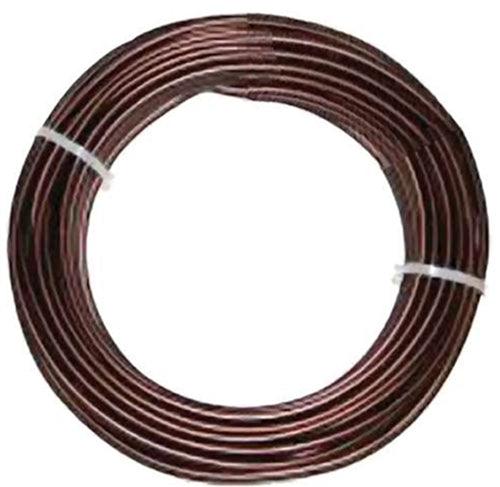
Hand held bonsai come in handy (so to speak). Without the hand, it would be difficult to say just how small this tree is. This little gem and the others shown here, look like Shimpaku junipers (Juniperus sargentii Shimpaku)
I just stumbled upon a new one for me. It’s called DANY Bonsai. The translation is… “Danny small works. A world of creativity. Free and carefree.” Not a bad way to view the art of bonsai.
Continued below…
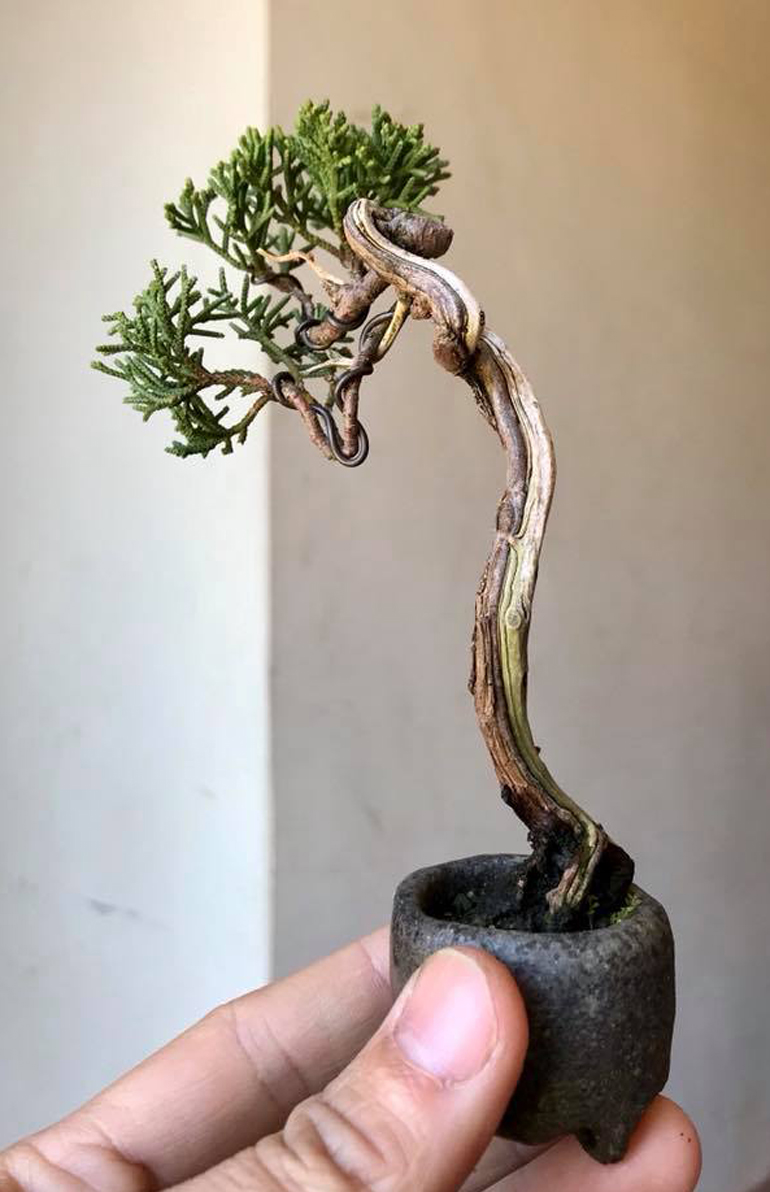
Tiny bunjin bonsai. This pot is even smaller that the one above
You don’tsee that many bonsai that are so tiny and yet so well developed. In fact, you don’t see that many tiny bonsai at all. Though some people lump all small bonsai into the group called Shohin, I think these qualify as Mame (Japanese for ‘Bean’)
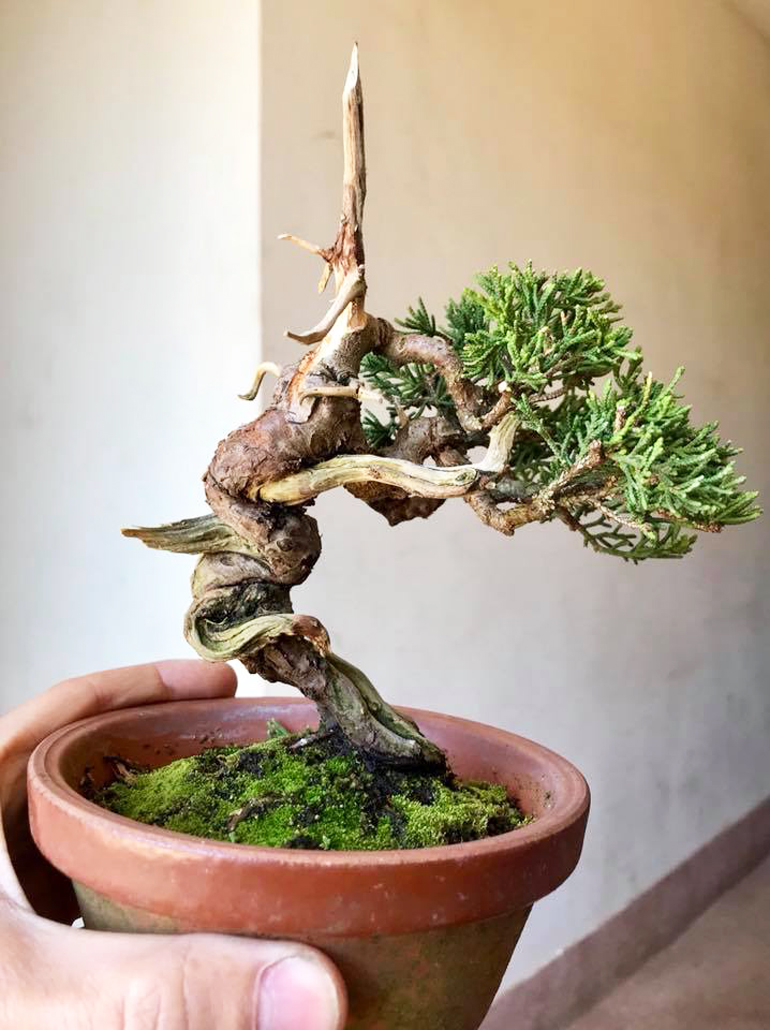
Twisted! Looks like it might be ready for a bonsai pot that is just a tad larger than the ones above
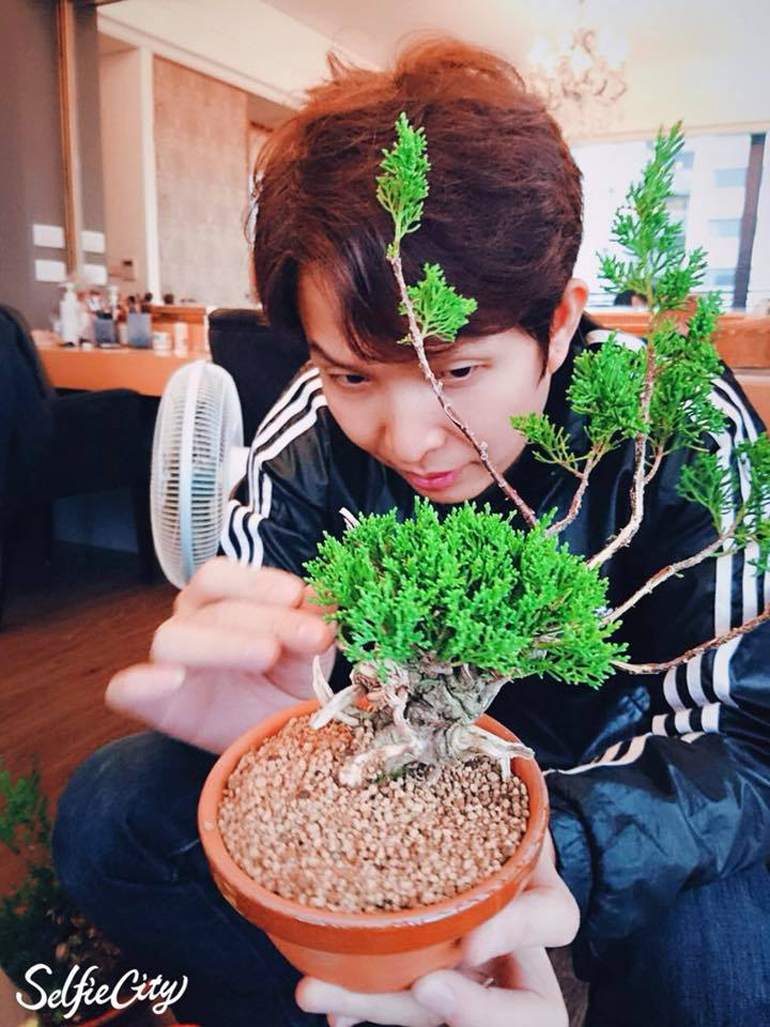
Danny, free and carefree
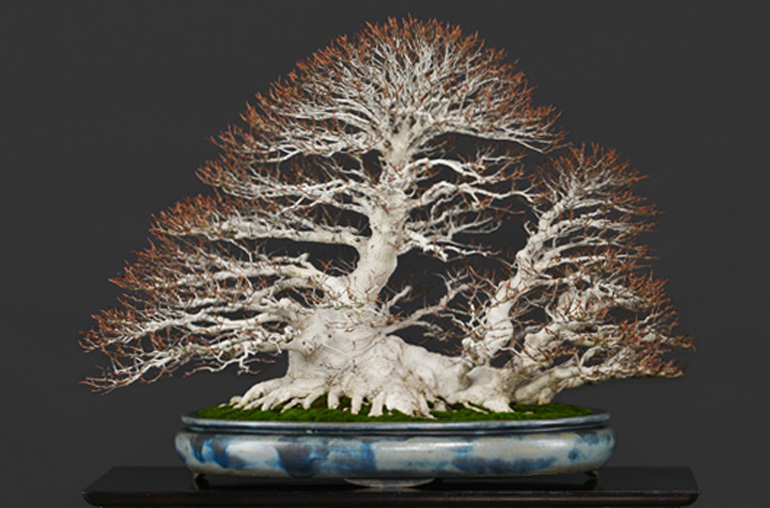 This magnificent Japanese beech (Fagus crenata) received the coveted Kokufu prize at the 88th Kokufu Bonsai Exhibition (the oldest and most prestigious bonsai exhibition in the world). Aside from its unique power and beauty, this tree provides a perfect example of what great ramification looks like (made even more obvious by the bright rusty-red leaf buds). The photo is from the World Bonsai Friendship Federation. Identification and other details were provided by Bill Valavanis.
This magnificent Japanese beech (Fagus crenata) received the coveted Kokufu prize at the 88th Kokufu Bonsai Exhibition (the oldest and most prestigious bonsai exhibition in the world). Aside from its unique power and beauty, this tree provides a perfect example of what great ramification looks like (made even more obvious by the bright rusty-red leaf buds). The photo is from the World Bonsai Friendship Federation. Identification and other details were provided by Bill Valavanis.
Yesterday we discussed ramification so we’ll keep going with this post that we last featured in January, 2015.
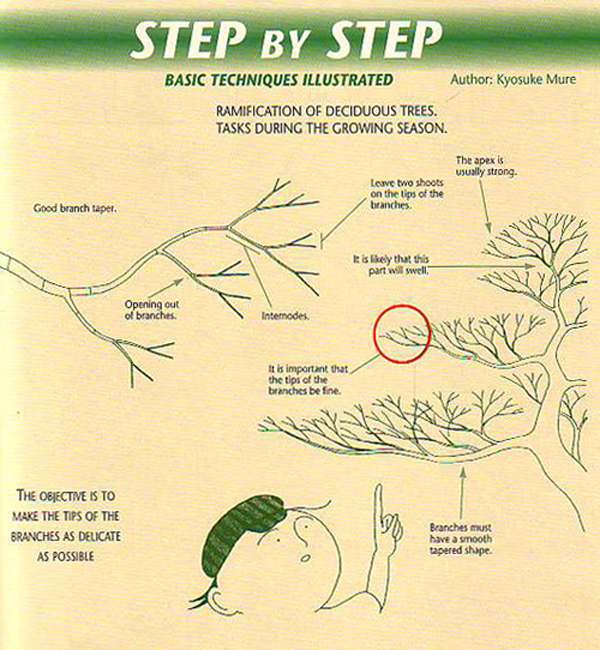
This illustration (originally from Bonsai Today magazine) is one of many that we featured in a three part series of posts from 2010 (links provided below). The following text is from the first post in the series...
Ramification literally means branch development, or how branches grow. However, when it comes to the art of bonsai, it has come to mean branch development that displays a couple key features: taper and fine tips. These related features are critical when it comes to developing quality deciduous (and other) bonsai.
Deciduous trees develop rapidly, but they also lose their shape rapidly. With precise pruning and pinching, you can create excellent fine branching in just a few years. But it’s an on going process that requires continued pruning and pinching to maintain… (there’s more here, here and here).
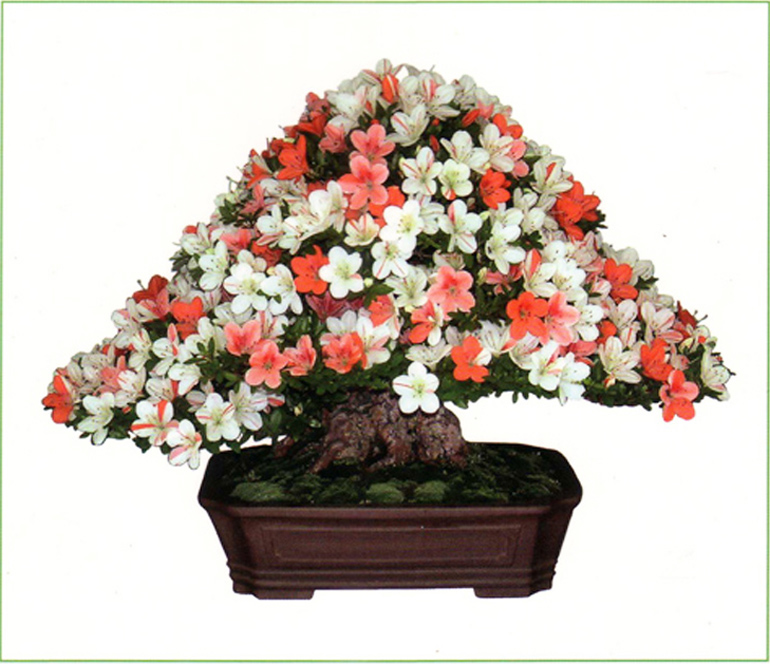 Ramification is not just about deciduous trees. A lot of skilled pinching and pruning is behind this Satsuki azalea’s wild profusion of flowers. The photo, which we featured in another 2010 post on ramification, is from Robert Callaham’s benchmark Satsuki Bonsai book (out of print).
Ramification is not just about deciduous trees. A lot of skilled pinching and pruning is behind this Satsuki azalea’s wild profusion of flowers. The photo, which we featured in another 2010 post on ramification, is from Robert Callaham’s benchmark Satsuki Bonsai book (out of print).

Please excuse the fuzz. I lifted this image from youtube and the fuzz came along on its own (there are some still shots below without much fuzz). It's a Field Elm (Ulmus minor) that belongs to Davide Cardin. The youtube video was shot at the 2016 Bonsai San Show in France.
You can learn a lot about deciduous bonsai in the winter. Particularly ramification (see below).
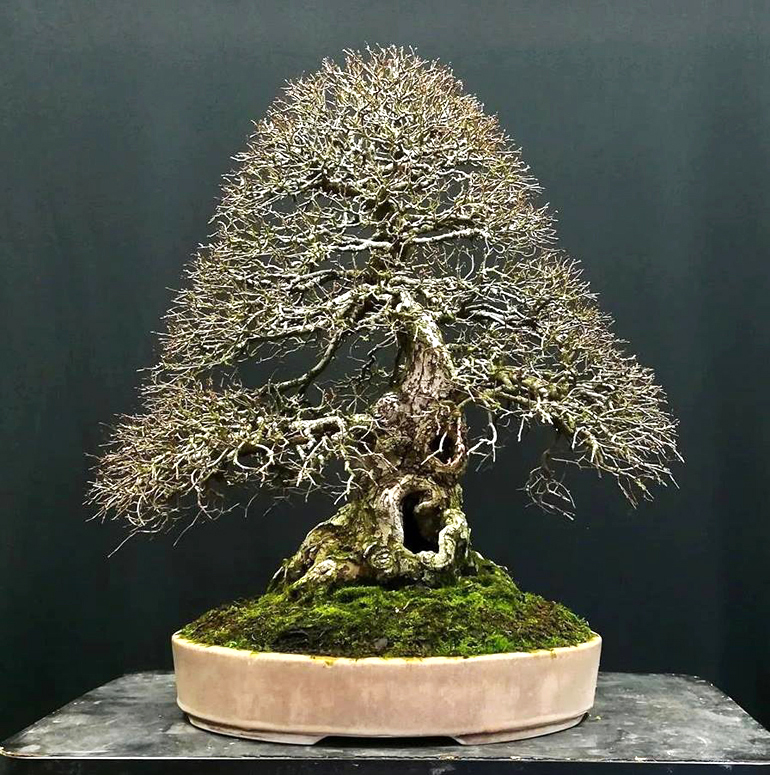
Same tree, different pot in this shot from Bonsai Addicted.I'm guessing that this shot was taken later than the one above, based on the ramification.
Ramification refers to branching, particularly how over time branching develops (ramifies). With enough time and skill (and the right type tree) you can develop the branching so that each branch becomes gradually narrower as it grows and multiplies from the trunk outward, until you have very fine, almost filigreed twigs at the outer reaches of the tree (see below).
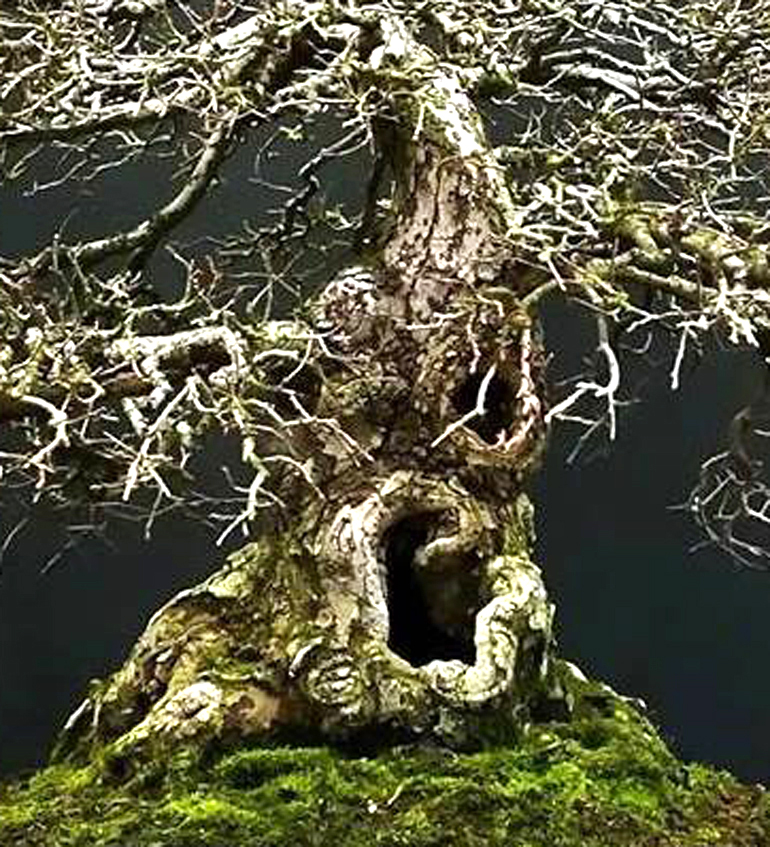
Trunk with sabamiki (hollow). Actually, two sabamiki
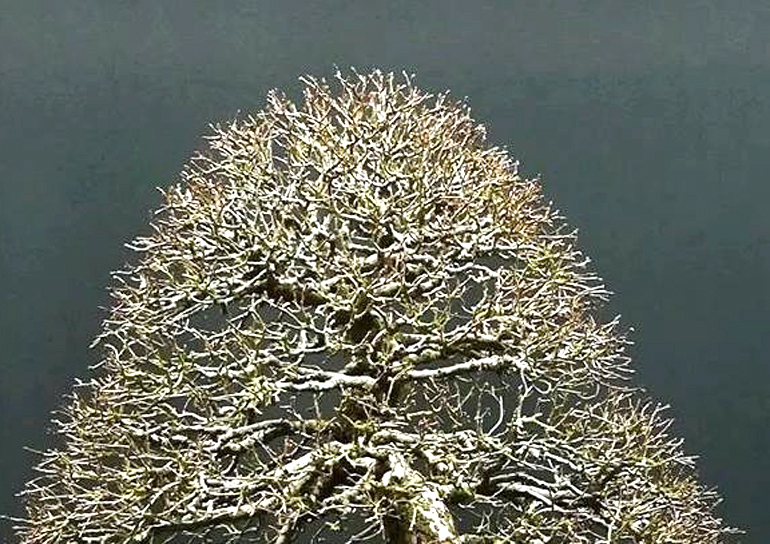
This closeup of the crown provides better look at the fine ramification
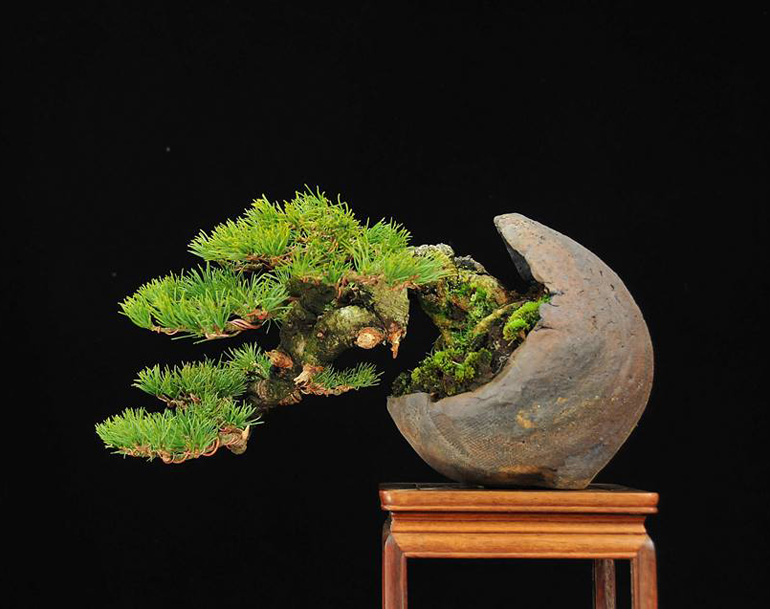
This luminous little Japanese white pine belongs to Suthin. It's a winner, right down to the pot and the yellow-green moss.
Continuing from yesterday with Suthin and pines. The three little trees in this post appeared here one year ago (March, 2017) and were originally from Suthin’s facebook photos
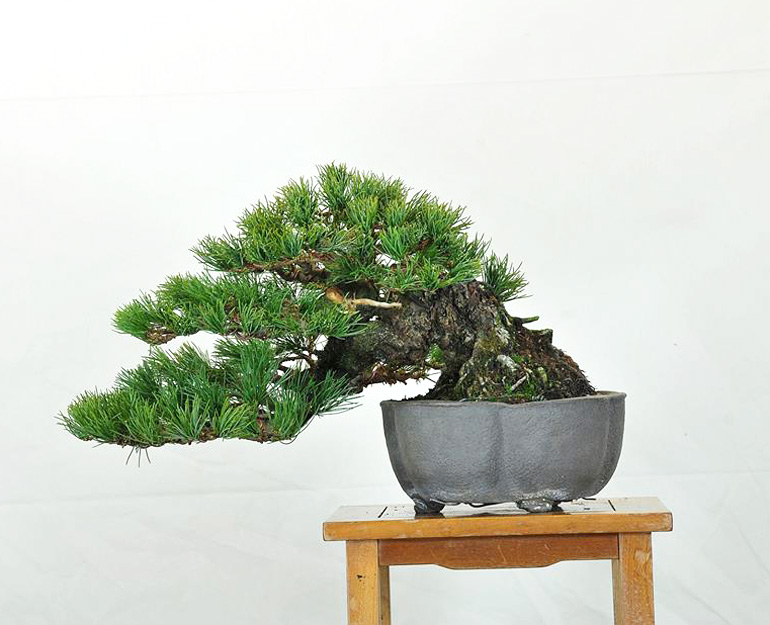
Another strong little Japanese white pine.
–
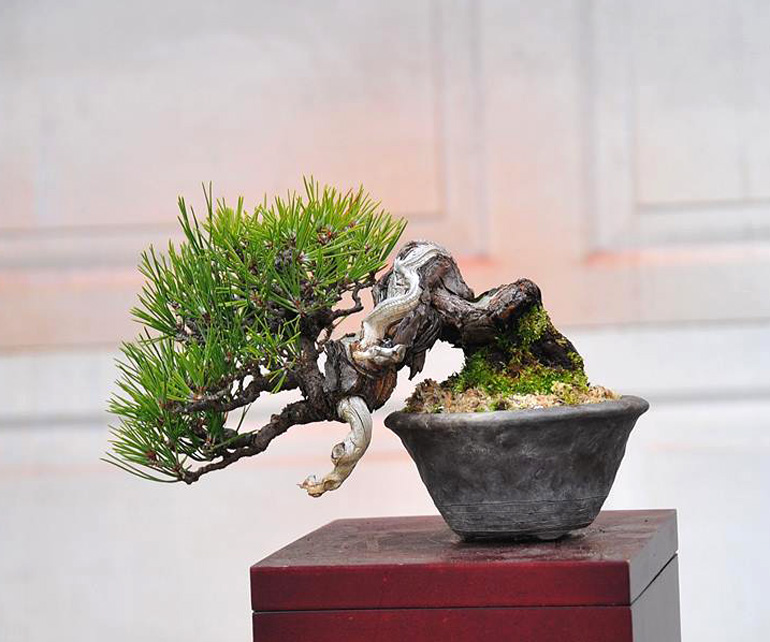
This rough little gem is a Japanese black pine. Still a little grooming to do, but all the right stuff is present.

Suthin's before and after Japanese five needle pine, aka Japanese white pine (Pinus parviflora aka Pinus parvifolia). This is the only variety tree that I know of that has two common names in English and two botanical names. To further confuse the issue, in bonsai circles it is sometimes referred to as Goyomatsu (Japanese - Goyo = five needle, Matsu = pine)
We never go too long without visiting our friend Suthin Sukosolvisit. If you’d like more, here’s a link to dozens of other Suthin posts we’ve featured over the years.
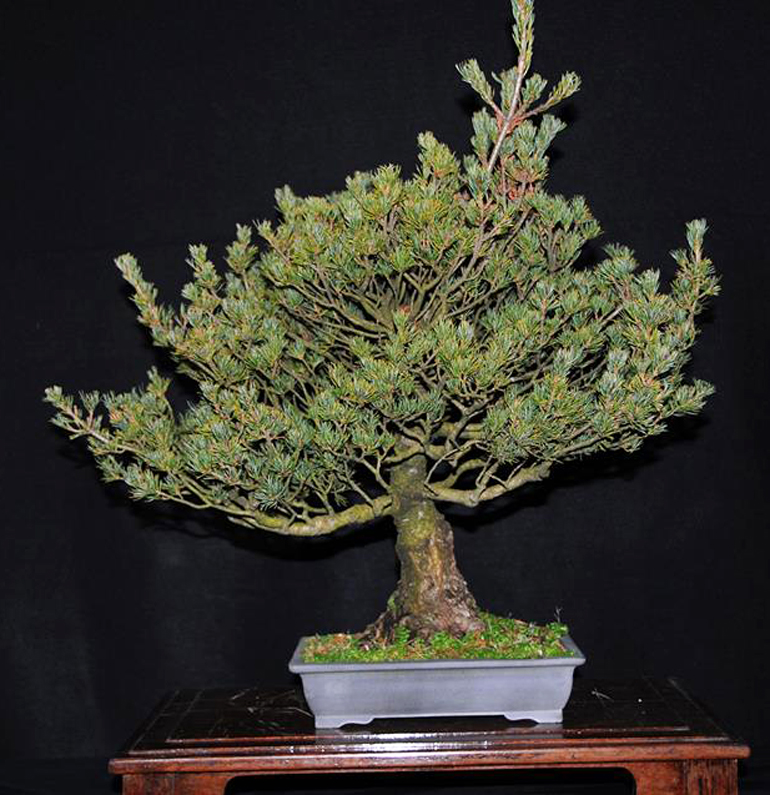
Before. A tree in need of styling and a new pot
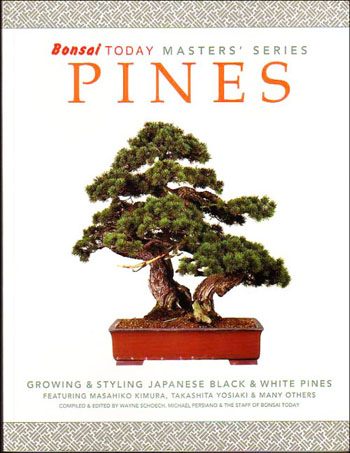
Wanna learn more about Japanese white pines?
Our Master’s Series Pine Book
list price 34.95
SPECIAL ONLY 22.95
see below
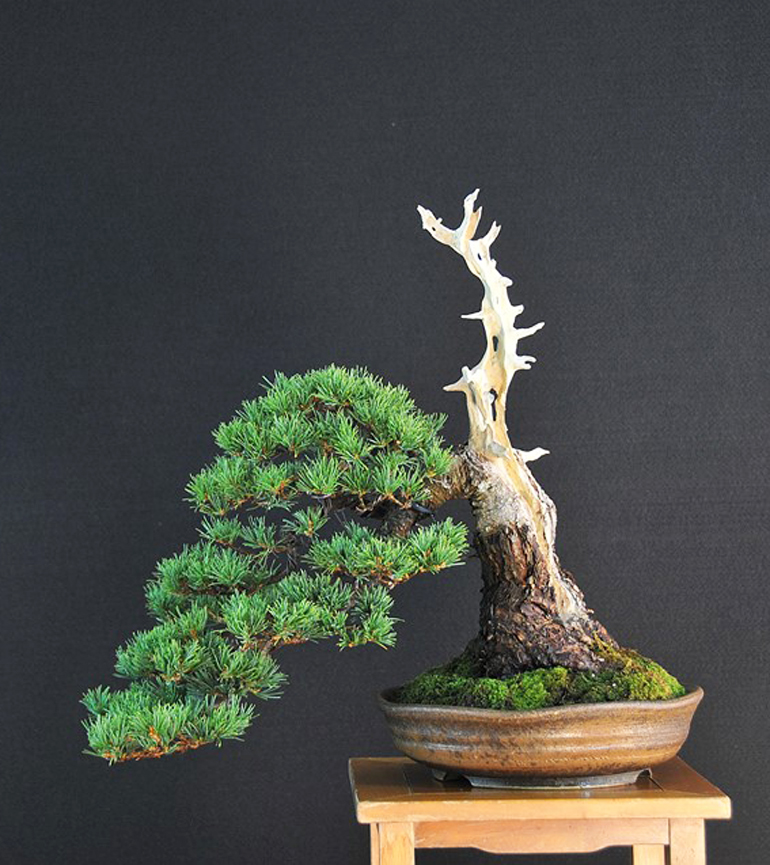
Another radical transformation! Suthin doesn't say how much time elapsed between the before and after.
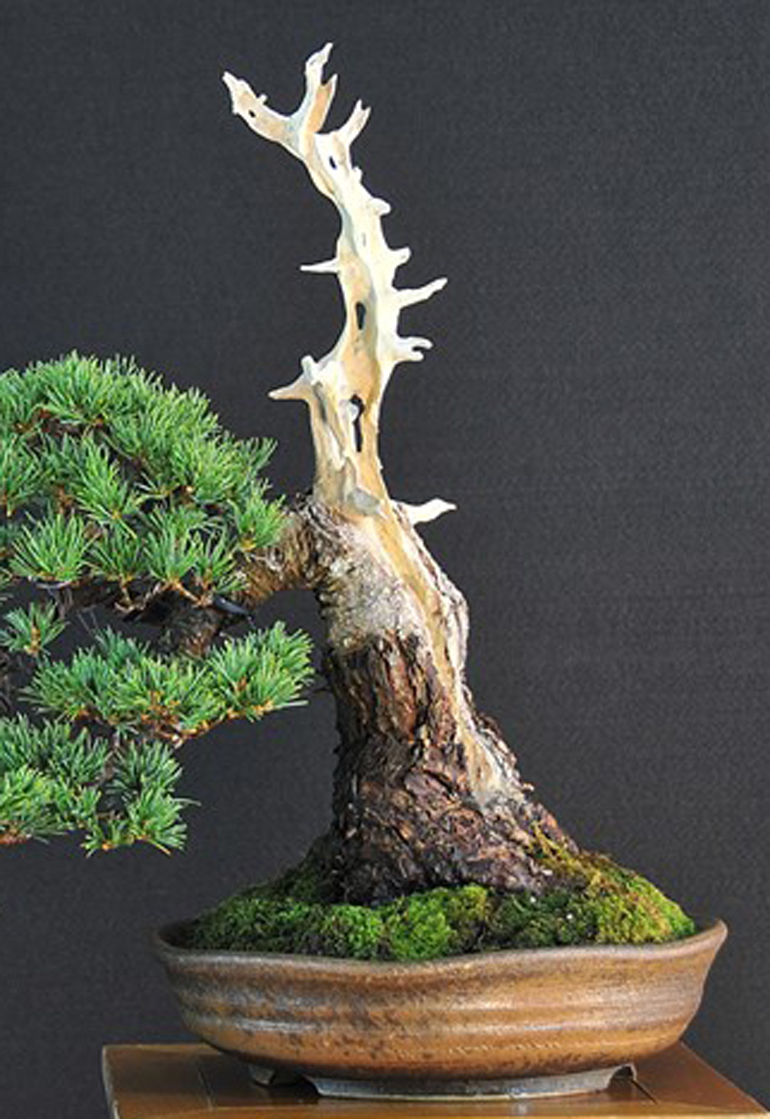
A closer look at the bark and Suthin's carving.

plus FREE Shipping on Continental U.S. orders 75.00 or more
–
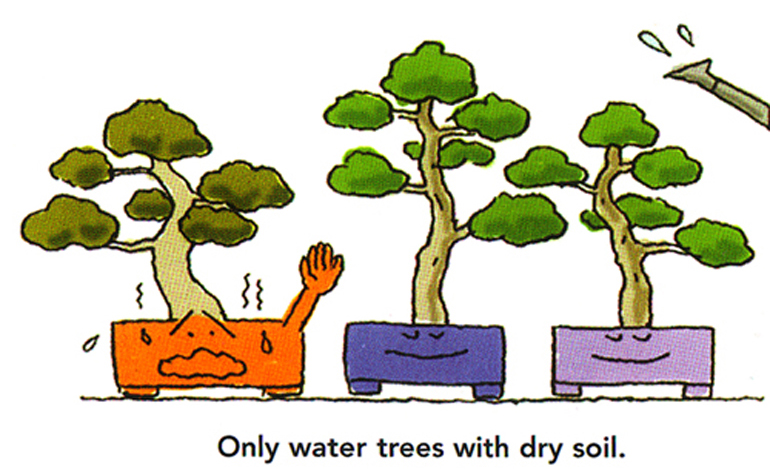 This illustration by Kyosuke Gun is from our Masters' Series Juniper book. It is a perfect fit for this post that is borrowed from Michael Hagedorn's Crataegus Bonsai.
This illustration by Kyosuke Gun is from our Masters' Series Juniper book. It is a perfect fit for this post that is borrowed from Michael Hagedorn's Crataegus Bonsai.
We originally featured this post in June, 2009. It’s one of our earliest and perhaps one of our most important. I don’t think we’ve featured it since 2009, clearly an oversight on our part. Especially considering the importance of the topic and our source. Michael Hagedorn knows more about the inner workings of bonsai and bonsai care than almost anybody, so paying attention to what he has to say is always a good idea.
The following is quoted from Michael…
“Before the real summer heat hits, consider how you are watering your trees. Have you ever seen your trees grow through spring just fine, only to get fried leaves at the first onset of early summer? Ever wonder why that happens?”
Continued below…

A Western hemlock (Tsuga heterophylla) 'cliff bonsai' from Michael Hagedorns' portfolio
Michael continued from above…
“Those trees just don’t have enough roots. Those are the trees that got overwatered, or simply never dried out, in the cool spring months. Their roots were never encouraged to hunt out water, so these trees could survive in the moist cool weather on about three roots. First hot day: bam, they get hit hard as they have a spindly root system, not enough to support their overlarge, over long leaves and shoots on dry hot days. (A bonsai version of a company that has overspent just before a recession…)
“Especially on cool overcast days, if you can monitor them, water each tree only when it is really drying out and not by rote. Watering by a schedule is the surest way to have some really weak trees that show themselves in the hot summer!”

This Sierra juniper by Boon Manakitivipart has the distinction of being on the cover of our final issue of Bonsai Today (issue 108). Bonsai Today magazine back issues are included in our Site Wide Sale which ends Sunday night (March 25th) at 11:59pm EDT
–
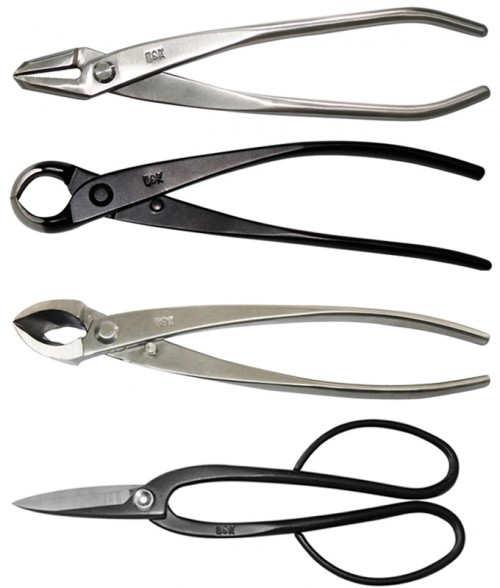


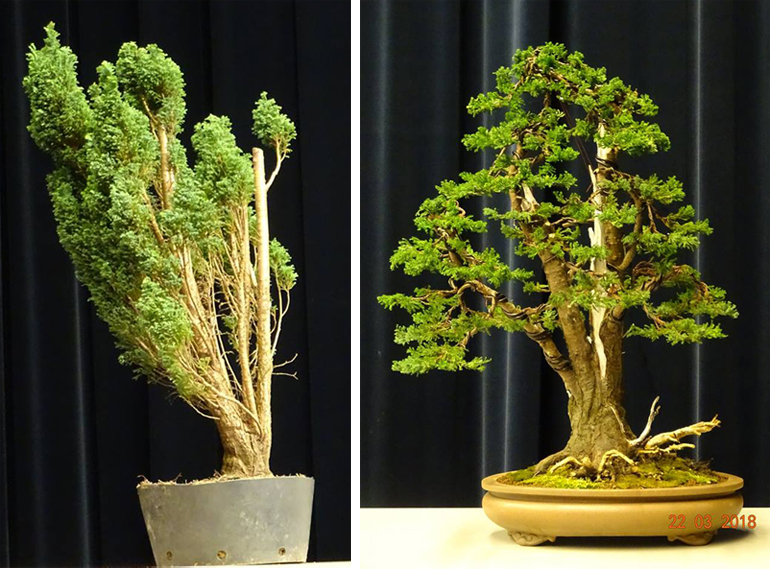
Before and after. The tree is a Lawson's cypress (Chaemacyparis Louïsiana 'Elwoodii'). Here's the caption copied directly from Michel Delen, our source for these photos... "Chaemacyparis Louïsiana 'Elwoodii' AFTER Grandioos Noelanders Marc."
I’m impressed. The date on the before is Feb 8th of this year and the date on the after is March 22nd (two days ago). Given just how little time elapsed, it’s an remarkable transformation. All the photos in this post are from
Michel Delen’s timeline.
–
You might assume from the caption and the photo below that the artist is
Marc Noelanders. It’s unclear who the tree belongs to, but perhaps it’s Michel’s. The untranslated word
Grandioos looks suspiciously like it might be Flemish (Belgian Dutch) for Grandiose. Maybe this is a way of saying
highly accomplished, or something like that.
Continued below…
–
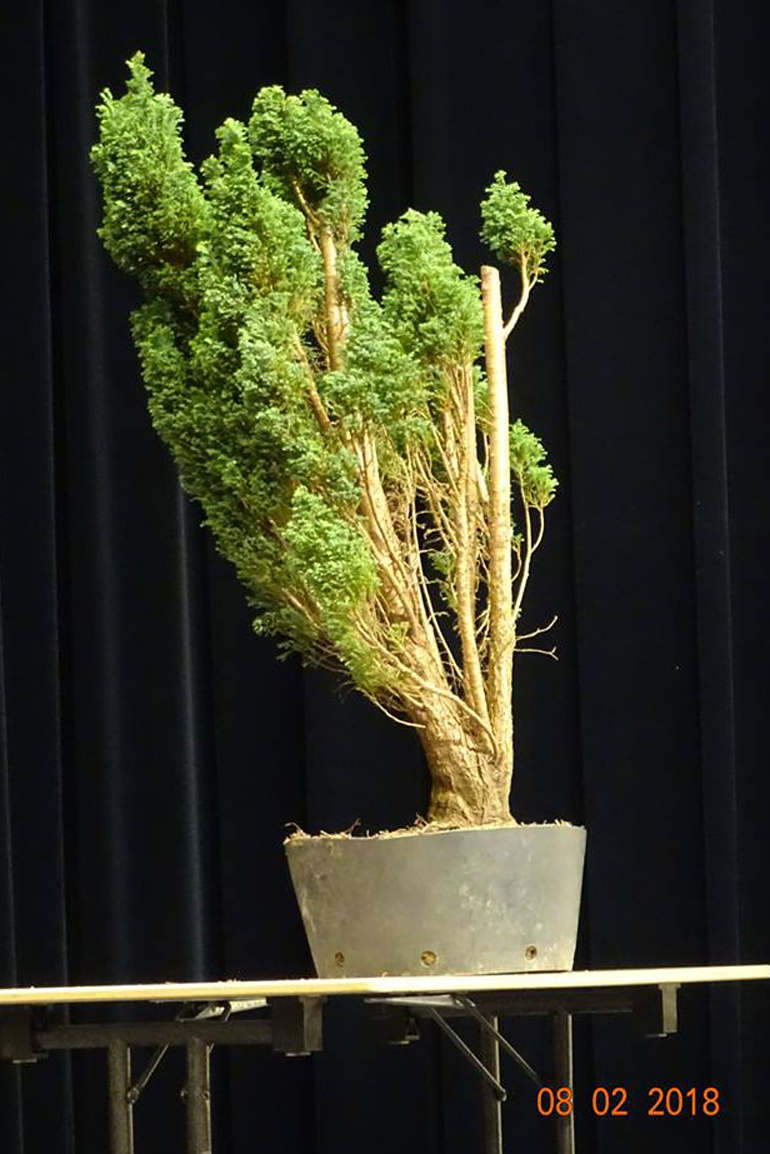
Before
Just in case you’re curious about Lawson’s cypress, here’s something from Dobbies Garden Center… “Lawson’s cypress all originate from seed collected in Oregon and California, USA and sent to Lawson Nursery near Edinburgh in Scotland in 1854. The modern cultivars spring from these plants.” You might wonder why the botanical name is C. Louïsiana if the species is from the West Coast. If so, you’re not alone.

After. A little soil removal and you've got a pretty good nebari. The deadwood around the base of the trunk must have been roots that were also exposed when soil was removed.

Marc Noelanders with tree and date

Fall. Luis Vallejo calls this tree a Spanish oak (Quercus faginea) though Wikipedia and some others refer to it as Portuguese oak (other names that popped up are Valencian oak and Lusitanian oak). It belongs to Luis and resides at the the Municipal Bonsai Museum of Alcobendas in Spain.
Welcome to Luis Vallejo’s Bonsai Bark (just kidding). This post features four photos of a single tree over three seasons (winter twice; not sure what happened to spring). There’s a lot more we could say, especially about the Museo de Bonsai Alcobendas and Luis Vallejo’s (and others) involvement, but it’s a whole lot easier to simply invite you to click here and get it straight from the source

Summer

Winter with companion

Winter with snow

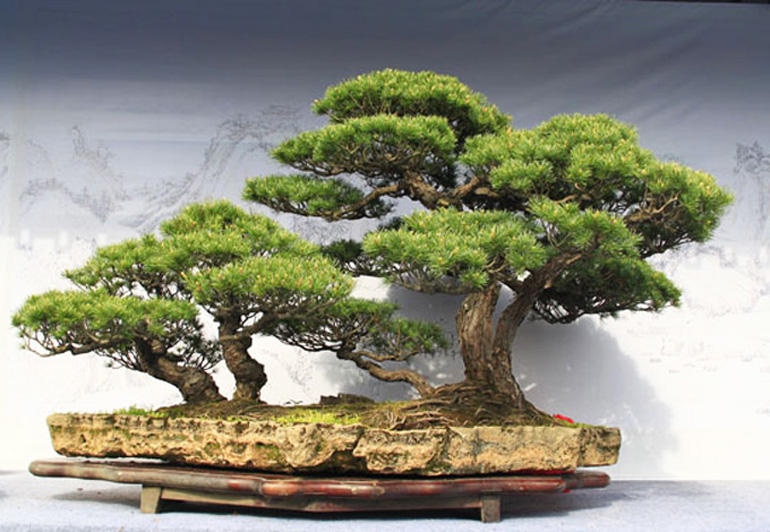

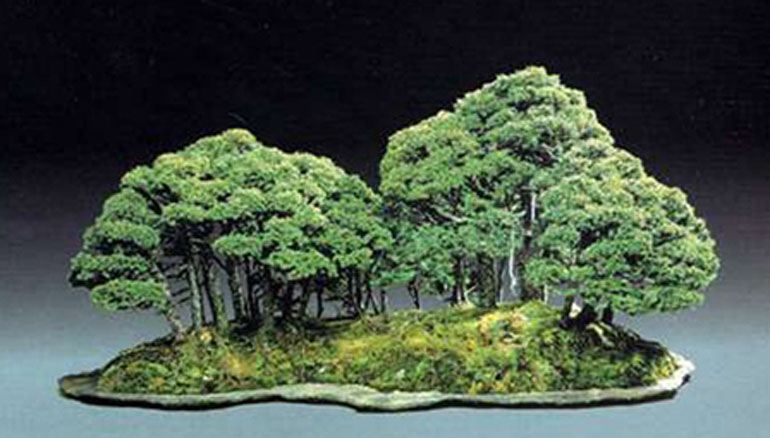 Recognize this? You probably do if you've been around for a while. If not, this is what a planting by a bonsai master might look like.
Recognize this? You probably do if you've been around for a while. If not, this is what a planting by a bonsai master might look like.





 This magnificent Japanese beech (Fagus crenata) received the coveted Kokufu prize at the 88th Kokufu Bonsai Exhibition (the oldest and most prestigious bonsai exhibition in the world). Aside from its unique power and beauty, this tree provides a perfect example of what great ramification looks like (made even more obvious by the bright rusty-red leaf buds). The photo is from the
This magnificent Japanese beech (Fagus crenata) received the coveted Kokufu prize at the 88th Kokufu Bonsai Exhibition (the oldest and most prestigious bonsai exhibition in the world). Aside from its unique power and beauty, this tree provides a perfect example of what great ramification looks like (made even more obvious by the bright rusty-red leaf buds). The photo is from the 
 Ramification is not just about deciduous trees. A lot of skilled pinching and pruning is behind this Satsuki azalea’s wild profusion of flowers. The photo, which we featured in another
Ramification is not just about deciduous trees. A lot of skilled pinching and pruning is behind this Satsuki azalea’s wild profusion of flowers. The photo, which we featured in another 












 This illustration by Kyosuke Gun is from our
This illustration by Kyosuke Gun is from our 












